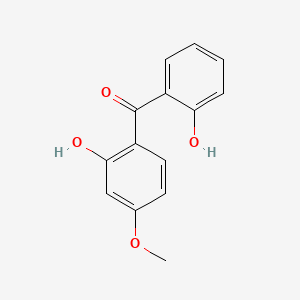D0632 | 2,2'-dihydroxy-4-methoxybenzophenone
| Toxicity | Dose | Time | Species | Model | Method | Action | Positive criterion | Reference |
|---|---|---|---|---|---|---|---|---|
| MEMBRANE POTENTIAL | 9.89±1.04 | human | qHTS-HepG2 | MMP assay | decrease | IC50 | 163 | |
| MEMBRANE POTENTIAL | 5.24 | human | HepG2 | MMP assay | decrease | IC50 | 163 | |
| MEMBRANE POTENTIAL | 11.08±5.21 | rat | hepatocytes | MMP assay | decrease | IC50 | 163 | |
| Pictogram | Signal | Statements | Precautionary Statement Codes |
|---|---|---|---|
 |
Warning |
Aggregated GHS information provided by 48 companies from 5 notifications to the ECHA C&L Inventory. Each notification may be associated with multiple companies. Reported as not meeting GHS hazard criteria by 5 of 48 companies. For more detailed information, please visit ECHA C&L website Of the 4 notification(s) provided by 43 of 48 companies with hazard statement code(s): H315 (95.35%): Causes skin irritation [Warning Skin corrosion/irritation] H319 (95.35%): Causes serious eye irritation [Warning Serious eye damage/eye irritation] H335 (90.7%): May cause respiratory irritation [Warning Specific target organ toxicity, single exposure Respiratory tract irritation] Information may vary between notifications depending on impurities, additives, and other factors. The percentage value in parenthesis indicates the notified classification ratio from companies that provide hazard codes. Only hazard codes with percentage values above 10% are shown. |
P261, P264, P271, P280, P302+P352, P304+P340, P305+P351+P338, P312, P321, P332+P313, P337+P313, P362, P403+P233, P405, and P501; (The corresponding statement to each P-code can be found at the GHS Classification page.) |
 |
Warning |
H315: Causes skin irritation [Warning Skin corrosion/irritation] H319: Causes serious eye irritation [Warning Serious eye damage/eye irritation] H335: May cause respiratory irritation [Warning Specific target organ toxicity, single exposure Respiratory tract irritation] |
P261, P264, P271, P280, P302+P352, P304+P340, P305+P351+P338, P312, P321, P332+P313, P337+P313, P362, P403+P233, P405, and P501; (The corresponding statement to each P-code can be found at the GHS Classification page.) |
| (2-Hydroxy-4-methoxyphenyl)(2-hydroxyphenyl)methanone | (2-hydroxy-4-methoxy-phenyl)-(2-hydroxyphenyl)methanone | (2-hydroxy-4-methoxyphenyl)-(2-hydroxyphenyl)methanone |
| (2-hydroxyphenyl)-(4-methoxy-2-oxidanyl-phenyl)methanone | 131-53-3 | 2,2 inverted exclamation marka-Dihydroxy-4-methoxybenzophenone |
| 2,2'-DIHYDROXY-4-METHOXYBENZOPHENONE | 2,2'-Dihydroxy-4-methoxybenzophenone (BP-8) | 2,2'-Dihydroxy-4-methoxybenzophenone, 98% |
| 2,2'-dihydroxy-4-methoxy benzophenone | 2,2'-dihydroxy-4-methoxy-benzophenone | 2,2'-dihydroxy-4-methoxybenzo-phenone |
| 2,2'-dihydroxy-methoxybenzophenone | 2,2\'-Dihydroxy-4-methoxybenzophenone | 2-(2-hydroxybenzoyl)-5-methoxyphenol |
| 2-2'-Dihydroxy-4-methoxybenzophenone | 2-2-dihydroxy-4-methoxybenzophenone | 2-hydroxy-4-methoxyphenyl 2-hydroxyphenyl ketone |
| A806277 | AB00051973 | AB00051973_08 |
| ACMC-209bn4 | AI3-25363 | AK-57636 |
| AKOS015856203 | AM720 | ANW-19358 |
| AX8064469 | Advastab 47 | B762XZ551X |
| BIDD:ER0352 | BPBio1_000788 | BRD-K22193694-001-05-2 |
| BRD-K22193694-001-08-6 | BRN 2055461 | BSPBio_000716 |
| BSPBio_002217 | Benzophenone, 2,2'-dihydroxy-4-methoxy- | Benzophenone,2'-dihydroxy-4-methoxy- |
| Benzophenone-8 | C-34297 | C14283 |
| CAS-131-53-3 | CC-06485 | CCG-40196 |
| CCRIS 6231 | CHEBI:34208 | CHEMBL1326877 |
| CS-4451 | Cyasorb UV 24 | Cyasorb UV 24 Light Absorber |
| D03853 | D0586 | DB11221 |
| DSSTox_CID_2403 | DSSTox_GSID_22403 | DSSTox_RID_76574 |
| DTXSID3022403 | Dioxibenzona | Dioxibenzona [INN-Spanish] |
| Dioxibenzonum | Dioxybenzon | Dioxybenzone (USP/INN) |
| Dioxybenzone [USAN:INN] | Dioxybenzone [USAN:USP:INN] | Dioxybenzone, United States Pharmacopeia (USP) Reference Standard; |
| Dioxybenzone, analytical standard | Dioxybenzonum | Dioxybenzonum [INN-Latin] |
| EINECS 205-026-8 | FT-0609243 | HMS1570D18 |
| HMS1920I04 | HMS2091O12 | HMS2097D18 |
| HMS2235J06 | HMS3371G16 | HMS3714D18 |
| HY-B0966 | J-506801 | K820 |
| KBio2_001458 | KBio2_004026 | KBio2_006594 |
| KBio3_001437 | KBioGR_001097 | KBioSS_001458 |
| KS-5318 | LS-741 | MCULE-2204733956 |
| MEZZCSHVIGVWFI-UHFFFAOYSA-N | MLS002154056 | Methanone, (2-hydroxy-4-methoxyphenyl)(2-hydroxyphenyl)- |
| NCGC00016393-01 | NCGC00016393-02 | NCGC00016393-03 |
| NCGC00016393-04 | NCGC00016393-07 | NCGC00094657-01 |
| NCGC00094657-02 | NCGC00258546-01 | NSC 56769 |
| NSC-56769 | NSC-756742 | NSC56769 |
| NSC756742 | Pharmakon1600-01500255 | Prestwick0_000898 |
| Prestwick1_000898 | Prestwick2_000898 | Prestwick3_000898 |
| Q2533641 | S4607 2,2 inverted exclamation marka-Dihydroxy-4-methoxyb | SBB057333 |
| SBI-0051353.P003 | SCHEMBL15894 | SMR001233373 |
| SPBio_001243 | SPBio_002925 | SPECTRUM1500255 |
| SR-05000001610 | SR-05000001610-1 | SR-05000001610-3 |
| ST033388 | ST2414188 | Spectra-Sorb UV-24 |
| Spectra-sorb UV 24 | Spectro-sorb UV 24 | Spectrum2_001032 |
| Spectrum3_000399 | Spectrum4_000519 | Spectrum5_000913 |
| Spectrum_000978 | TC-108103 | Tox21_110417 |
| Tox21_110417_1 | Tox21_200993 | UF 2 |
| UNII-B762XZ551X | UV 24 | W-108331 |
| ZINC37293 | ZX-AT029395 | component of Solaquin (Salt/Mix) |
| dioxybenzone | s4607 |

